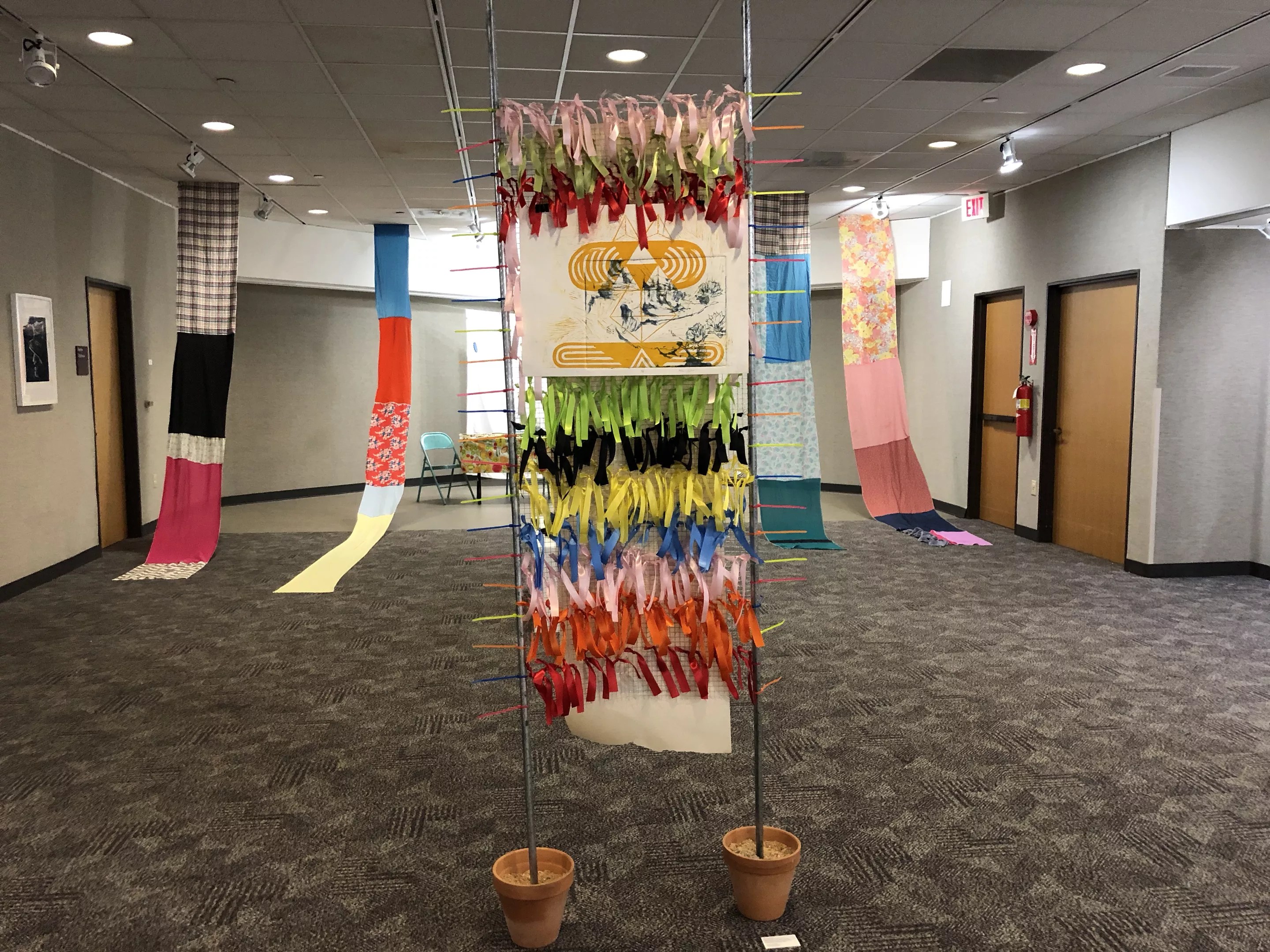
Angela Faz

Audio By Carbonatix
An indigenous woman bending over a loom. A bleeding heart with a political message. An altar with a Hamsa Hand, a snake, a candle. A tangle of cut braids of hair. A naked female torso. A projection of digital illustrations with a dream-like quality. These symbols and images from the Hecho a Mano / Made by Hand show invite viewers to make connections, to explore identity, to challenge established narratives.
According to curator Angela Faz, founder of Radical Love Art Collective, Hecho a Mano is a “journey about colonization,” where artists “unpack their identities in ways that are reflective of them.”
The works express many themes, like identity, “Latinidad,” ancestral healing, family and roots, immigration, and the African Diaspora. The display comprises different printing techniques, such as linocuts, woodcuts, posca on canvas, digital prints and animations, photography, ink drawings and illustrations. Art installations also interact with the prints, as not all artists are printmakers. One of the installations represents ancestral healing.
The works are laid out in such a way as to create a conversation that “focuses in on those identities playing off of each other,” Faz says. A print celebrating an artist’s Jamaican ancestry sits next to a work that represents African ancestors who were forcefully brought to the Americas. This is an example of a conversation Faz means to inspire.
Will you step up to support Dallas Observer this year?
At the Dallas Observer, we’re small and scrappy — and we make the most of every dollar from our supporters. Right now, we’re $16,250 away from reaching our December 31 goal of $30,000. If you’ve ever learned something new, stayed informed, or felt more connected because of the Dallas Observer, now’s the time to give back.
“The vision of the show was to create an intentional space for LGBTQ+, POC and Latinx folks,” Faz states. “I didn’t know very many QPOC in Dallas, and I wanted to create a safe space for that expression that doesn’t get usually spoken about.” Thus, Faz put out a call for artwork that “reflects the experiences of queer, Latinx and POC in all stages of visibility.”
Artists found a place where they were able to comfortably express “their various relations to the diaspora, colonization, immigration, gender identity and pre-Columbian rituals in a government building.”
The artists who answered that call and whose works were selected include Andrea Tosten, Braulio Lazon Conde, Cocoatlicue, Danielle Ellis, Elva Chávez, Erik Gomes, Fabiola Valenzuela, Fernando de Ita López, Goretti Troncoso Cordourier, Jodi Voice Yellowfish, Jamila S. Mendez, Jessica Sanchez, Juanita Segovia, Lola Lovenotes, Mayra Martinez, Montoya de la Hoya, Nistasha Perez, Paloma Salas, Serina Rodríguez and Violeta.
Some of these artists are in mid-career, some have been featured in the Texas Biennial, whereas some have never shown before in a gallery setting.
“I wanted a cross-pollination of people,” Faz emphasizes, referencing a need to connect with others, to get outside the usual circles and borders, and to give under-served artists visibility. The selected artists come from a variety of communities and backgrounds. This universe includes calligraphers, printmakers, bookbinders, designers, illustrators, American Indian activists and screen printers.
Faz sees the role of curator as that of “a midwife for art projects.” Apart from selecting artwork, other tasks include helping three of the artists by sharing their knowledge of materials in order to make their visions come true. The selection criteria for the artworks was based both on the content and the conversation potential between the pieces and within the space of the gallery.
“The vision of the show was to create an intentional space for LGBTQ+, POC and Latinx folks.” — Angela Faz
The inspiration for the show came from the curator’s six-week residency for printmaking in Puebla, Mexico, in 2018. The residency gave Faz the chance to research their ancestral roots, the consequences of colonization, and the accompanying mythologies. (Faz is non-binary and uses the pronouns “they.”)
Faz was impressed by the work, art and resourcefulness of small Mexican self-funded printmaking collectives, and used that model as catalyst to create a similar art collective in Dallas. That was how Radical Love Art Collective, an LGBTQ+ person of color printmaker collective, came to be.
A native of Dallas, Faz is an interdisciplinary Latinx artist who focuses on social justice issues. Their artwork explores the intersections of race, class and gender and often connects the personal and political. Exploring their connection to indigenous, Mexican and American ancestry, the work explores the varying relationships between popular culture and fine art. Last year, Faz was selected as one of the artists for Rising Stars, a Turner House exhibition showcasing emerging artists.
While art is ever subjective, meaning different things to different people, it inevitably provokes unexpected reactions. It pushes boundaries by asking questions, making the viewer dig deep in our own selves to find the answers. Thus, we find surprising connections between the art, the artist and ourselves. The symbolism and imagery in the Hecho a Mano show achieves that in a joyful manner.
The Radical Art Collective will hold a special event Saturday. During the Hecho a Mano Beyond Pride Pop-Up Workshop, participants can make a print, receive advice on materials and execution, enjoy art and poetry, and make connections in a supportive environment – like a Pride event without corporate sponsorship.
Hecho a Mano/Made by Hand is on display at the Lillian Bradshaw Gallery, located on the 4th floor of the J. Erik Jonsson Central Library, until June 29.